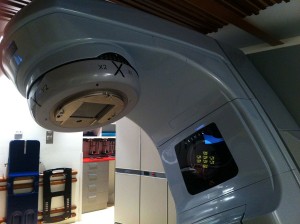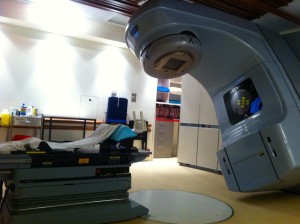26. What Really Happens When You Have Radiotherapy?
Radiotherapy is often recommended after breast cancer surgery – usually after breast conserving surgery. It is to remove any remaining undetected cancer cells and to reduce the risk of breast cancer returning.
Radiotherapy uses x-rays, gamma ray, electron beams or protons in treatment. Radium is no longer used, though this is what some people think radiotherapy is.
It is a localized treatment, targeting the area affected by cancer. While it’s aim is to kill off any cancer cells, it can also damage healthy cells, but they can usually repair themselves.
Not all hospitals provide this service, but I had chosen a hospital that was connected with the Peter MaCallum Cancer centre so I could have my treatment locally. As I would be going five days a week for six weeks, this seemed like a wise move.
A lot of people say they find the treatment tiresome, maybe because it’s for six weeks and that sounds demanding. I found it to be fairly straight forward. The hospital was only a short drive from home and I was usually able to get there, have treatment and be home again within a hour.
I nominated the time slot around 8.30-9.30 as I thought it fair to leave earlier times for those who had to go to work everyday. I only start work at 9am one day a week and was able to build up time in lieu and was always at work by 10am that day.
My radiotherapy was delivered externally. There are other treatments of internal radiotherapy (brachytherapy) and some treatments are delivered at an intensive dose during surgery, though this is fairly new in Australia.

The machine used for my treatment is called a linear accelerator. It is jokingly referred to as ‘the mix master’ as it looks like a giant mixer.
Let me describe a typical visit for my radiotherapy treatment.
First I check in at reception and confirm my time for the next day as the therapists change the scheduling sometimes. Then I wait till I’m told to ‘go around’ to the treatment area. I collect my own personal gown from a specially labelled cupboard (my gown had my name pinned to it, a bit like starting school!) then I go to the changing area which has 4 small cubicles for changing. First I collect my red ‘shopping basket’ to put my clothes in. It’s easiest to wear pants or a skirt as I only have to take my top layers off. There is also a toilet off this area and a bench to sit on while waiting – it reminds me of a bus stop! Sometimes there is another person waiting. The therapists always come down to greet their patient and walk us into the treatment room. In the treatment room I put the basket on a seat and look at my details up on the big screen on the wall and each time I have to say my name, date of birth and area being treated. Then I remove my gown and lay on the table which has a sheet on it. I have a bolster placed under my knees and my head rests on a small riser. I raise my arms about my head and hold onto two grips, the same as when I was mapped.

Table under Linear Accelerator
The large machine is centered directly above and green lights appear, making lines across my chest. These are lined up with my tattoos and measurements. When they look accurate, the therapists make measurements with a cold steel ruler and the bed is adjusted by a remote control. If I am not quite in the right spot, the therapists tug on the sheet under me to move me so I’m in exactly the right spot. They cover my right breast with the gown, just leaving the left exposed.
When they are satisfied I’m reminded not to cough, sneeze or move my arms – or anything else! They then dim the lights and leave me. An alarm sounds to indicate radiotherapy is in progress. It’s just me and the machine which whirrs, clicks and clunks behind me. The head of the linear accelerator swings slowly down to my left side. More noises and then the sound changes to a soft buzzing as the radiation is delivered. The machine moves again and is directly above me and buzzes again. It’s third movement is to my right and is fairly close to me but I don’t feel claustrophobic at all. The final dose is delivered and the machine clicks and I know that’s it for another day.
The staff return and lower the bed and I can get off – as gracefully as possible. Then I pick up my basket and head off to get changed and leave.
Most days this whole procedure only takes about 20 minutes from the time I arrive till I leave. The actual radiotherapy delivery is about one and a half minutes, done in three shorts bursts in that time – probably a total of 19 seconds by my count.
Does it hurt? No. Do I feel anything? No. Does it bother me? No.
I’m asked how I deal with it. I had discussed ‘visualizing’ with someone who recommends this to their clients. I have used this technique successfully at the dentist before. I put in headphones, listen to some lovely music and imagine I am somewhere I love going. Maybe the beach or a beautiful place in the country.
I consider using this during treatment but as it’s so brief, it’s not really going to work. It all happens very fast and then I’m out and on with my day.
For some people, radiotherapy can be intimidating and scary, but for me the treatment becomes just another part of my daily routine.
